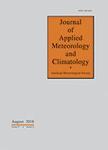版权所有:内蒙古大学图书馆 技术提供:维普资讯• 智图
内蒙古自治区呼和浩特市赛罕区大学西街235号 邮编: 010021

作者机构:Carnegie Mellon Univ Dept Stat & Data Sci Pittsburgh PA 15213 USA Mississippi State Univ Dept Geosci Mississippi State MS 39762 USA Colorado Sch Mines Dept Appl Math & Stat Golden CO 80401 USA
出 版 物:《JOURNAL OF APPLIED METEOROLOGY AND CLIMATOLOGY》 (应用气象学杂志)
年 卷 期:2020年第59卷第10期
页 面:1671-1689页
核心收录:
学科分类:07[理学] 070601[理学-气象学] 0706[理学-大气科学]
基 金:National Science Foundation [DMS-1520786] Mississippi State University Office of Research and Economic Development
主 题:Tropical cyclones Satellite observations Classification Statistics Model interpretation and visualization
摘 要:Tropical cyclones (TCs) rank among the most costly natural disasters in the United States, and accurate forecasts of track and intensity are critical for emergency response. Intensity guidance has improved steadily but slowly, as processes that drive intensity change are not fully understood. Because most TCs develop far from land-based observing networks, geostationary satellite imagery is critical to monitor these storms. However, these complex data can be challenging to analyze in real time, and off-the-shelf machine-learning algorithms have limited applicability on this front because of their black box structure. This study presents analytic tools that quantify convective structure patterns in infrared satellite imagery for overocean TCs, yielding lower-dimensional but rich representations that support analysis and visualization of how these patterns evolve during rapid intensity change. The proposed feature suite targets the global organization, radial structure, and bulk morphology (ORB) of TCs. By combining ORB and empirical orthogonal functions, we arrive at an interpretable and rich representation of convective structure patterns that serve as inputs to machine-learning methods. This study uses the logistic lasso, a penalized generalized linear model, to relate predictors to rapid intensity change. Using ORB alone, binary classifiers identifying the presence (vs absence) of such intensity-change events can achieve accuracy comparable to classifiers using environmental predictors alone, with a combined predictor set improving classification accuracy in some settings. More complex nonlinear machine-learning methods did not perform better than the linear logistic lasso model for current data.